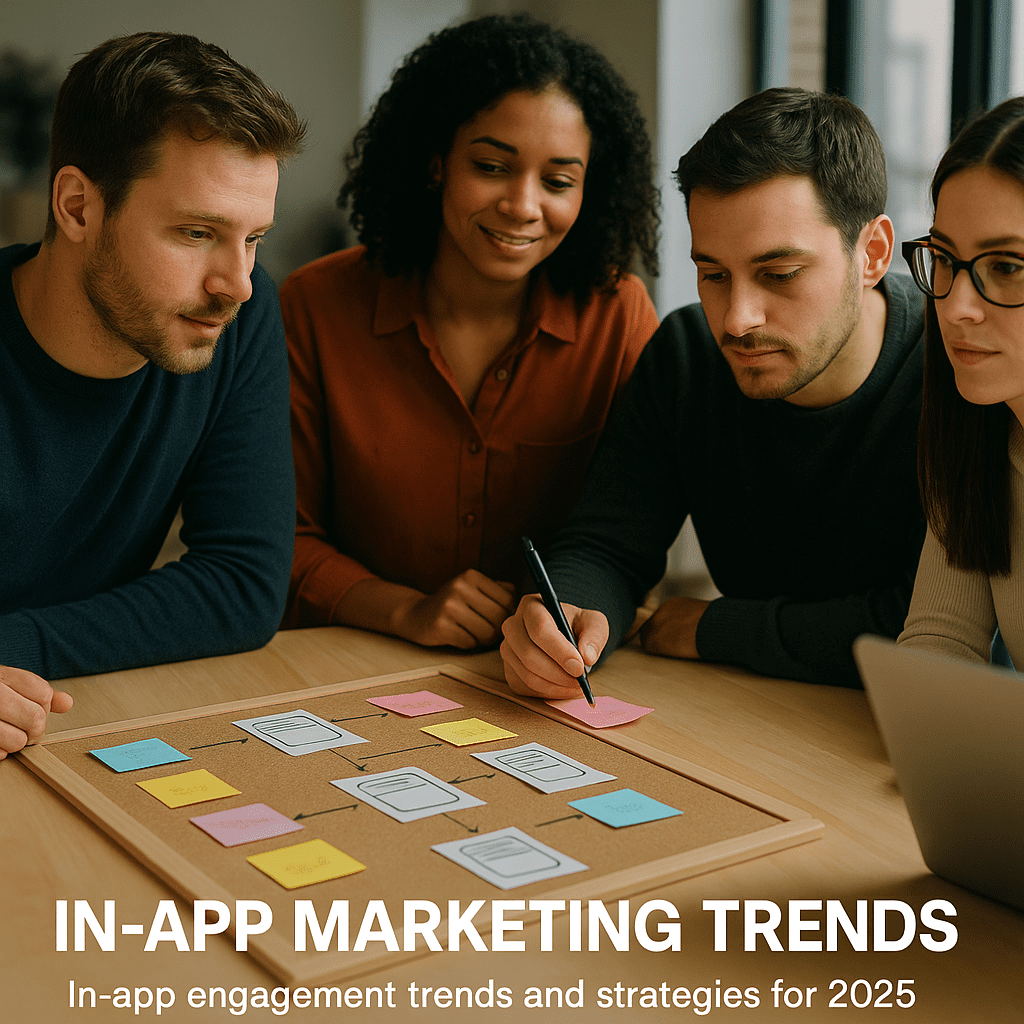
In-App Marketing Trends: Engagement Strategies for 2025
The mobile ecosystem is more competitive than ever. In 2025, app marketers, growth managers, and performance teams must leverage cutting-edge tactics to capture attention, drive conversions, and foster long-term loyalty. From seamless journey orchestration to immersive experiences, this guide—drafted from industry benchmarks and Admiral Media research—outlines the data-driven trends and strategies that top agencies and CMOs are using to scale app growth.
The State of In-App Marketing in 2025
Optimism runs high: according to Admiral Media’s Q1 2025 benchmark report, 80% of app marketers anticipate growing budgets this year, and nearly 50% have already secured incremental funding compared to 2024. This positive outlook aligns with accelerating user adoption—global app downloads surpassed 240 billion in 2024, per Business of Apps.
Yet user expectations are shifting. Over 60% of marketers report that their core audience’s behaviors changed significantly in the past two years, citing privacy concerns, platform updates, and more discerning engagement habits. To stay ahead, teams must pivot from one-size-fits-all campaigns to hyper-targeted, data-driven experiences.
Key In-App Engagement Trends for 2025
Deep Linking and Owned Media Optimization
Deep linking has evolved from a nice-to-have to a foundational component of any growth stack. By routing users directly from ads, emails, or social posts into specific in-app content, deep links reduce friction, boost conversion rates, and improve attribution accuracy.
According to Admiral Media, brands leveraging advanced deep-link infrastructure report:
- 64% uplift in owned media conversion
- +77% year-over-year growth in web-to-app conversions
- +45% email-to-app, +29% SMS-to-app, and +16% QR-to-app engagement increases
Best practice: integrate deep links into onboarding flows and re-engagement campaigns. For example, push abandoned-cart visitors straight into a checkout screen rather than the home page.
Omnichannel Marketing Automation
Users expect coherent journeys across devices. Omnichannel marketing automation synchronizes touchpoints—email, push notifications, in-app messages, SMS, and web—into a unified experience. This approach increases contextual relevance and reduces channel fatigue.
Example workflow: a user browses a product on desktop, receives a personalized email reminder, and then sees a limited-time discount push notification on mobile the next day—driving reactivation and purchase.
AI and Machine Learning Integration
Artificial intelligence underpins the modern growth stack. From predictive analytics that forecast user churn to recommendation engines that surface relevant content, AI accelerates decisioning at scale.
- Personalized recommendations: 50% higher click rates when suggestions align with past behavior.
- Chatbots & in-app support: 24/7 engagement while capturing behavioral data for further segmentation.
- Automated creative optimization: Real-time A/B tests to identify high-performing messages and visuals.
Learn more about AI in mobile marketing on the Admiral Media blog.
Augmented Reality Experiences
Augmented reality (AR) is no longer confined to gaming. Retail and ecommerce apps are using AR to let users virtually “try on” products or preview furniture in their homes. Engagement metrics speak volumes:
- AR feature sessions are 2.5× longer than non-AR sessions
- Purchase intent lifts by 45% when AR previews are available
AR SDKs like ARKit (iOS) and ARCore (Android) make integration smoother. Brands using AR see not only higher conversion rates but also stronger social sharing and earned media.
Essential App Engagement Metrics for 2025
Data-driven marketers focus on a balanced scorecard of engagement metrics. Here are the five KPIs to prioritize:
1. Daily and Monthly Active Users (DAU/MAU)
The DAU/MAU ratio measures user “stickiness.” A ratio above 20% signals strong habitual use. According to Business of Apps, the average user interacts with nine apps per day and 30 per month, underscoring fierce competition for mindshare.
2. Retention Rates
Day-1, Day-7, and Day-30 retention rates reveal drop-off patterns. Identifying where users churn helps optimize onboarding, in-app tutorials, and push re-engagement strategies. Top performers in the Admiral benchmark maintain a Day-30 retention above 15%.
3. Session Length & Frequency
Higher session counts and longer dwell times correlate with deeper feature adoption. Track both average session duration and sessions per user to diagnose engagement quality versus quantity.
4. Conversion Rates
Whether the goal is subscription sign-ups, in-app purchases, or ad clicks, conversion metrics capture funnel efficiency. Use granular funnels—e.g., onboarding step completion, feature use—to pinpoint optimization opportunities.
5. User Lifetime Value (LTV)
LTV informs acquisition budgets. By segmenting users by acquisition channel, campaign, or cohort, you can calculate channel-specific LTV and optimize spend toward the most profitable sources.
Effective Engagement Strategies for 2025
Gamification
Gamification taps into intrinsic motivators—competition, achievement, and reward—to drive engagement. Admiral data shows gamified onboarding boosts trial usage by 54% and increases purchase clicks by 15%. Elements like points, badges, and leaderboards can be woven into non-gaming apps—from fitness to finance—to nurture habitual use.
Tip: Align rewards with business goals. For example, reward users for completing their profile with a time-limited discount or bonus content unlock.
Hyper-Personalization
“One-size-fits-all” is dead. Hyper-personalization uses real-time behavior, location, and user preferences to deliver tailored content and offers. Marketers who implement dynamic user segmentation and real-time content injection see up to 300% uplift in engagement, per Admiral Media.
Performance Optimization
Technical performance underpins user satisfaction. Business of Apps reports that 70% of users abandon slow-loading apps. Routine performance audits—covering load times, memory usage, and crash rates—are non-negotiable. Implement continuous monitoring (e.g., via Firebase Performance Monitoring or Sentry) and set SLAs for critical KPIs (e.g., <2 sec load times).
Influencer Partnerships
Influencer marketing has matured beyond broad-brush celebrity campaigns. Today’s top apps partner with micro- and nano-influencers to reach niche communities authentically. Admiral’s benchmark shows that targeted influencer activations can lift installs by 20% and reduce cost per install by up to 30%.
Read more on Influencer Marketing for Apps.
Challenges and Considerations
Evolving Privacy Landscape
With iOS 15+ privacy changes, GDPR, and CCPA enforcement, transparent data practices are mandatory. Leading brands adopt consumer-driven data models, offering clear opt-in flows and granular consent controls. This not only ensures compliance but builds user trust—critical for long-term engagement.
Intensifying Competition
Over 3 million apps vie for attention in app stores. Admiral’s data indicates that over 55% of marketers face more aggressive KPI targets year-over-year, especially in North America and Western Europe. To stand out, embrace innovation—not just in features but in marketing tactics, creative formats, and channel mix.
Technical Complexity
Integrating multiple SDKs (analytics, deep linking, personalization, push) can bloat your app and introduce instability. Prioritize a modular, lightweight tech stack and conduct regular dependency audits. Establish clear governance around SDK usage, version updates, and peer-code reviews.
Looking Ahead: The Future of In-App Marketing
As we close 2025, several emerging trends merit close attention:
- 5G-Powered Experiences: Ultra-low latency will enable real-time AR/VR features, live multiplayer events, and richer media content.
- Voice UI Integration: Voice-activated in-app commands and support will open new accessibility and convenience pathways.
- Cross-Platform Journeys: Expect deeper alignment between web, mobile, and even IoT touchpoints for seamless brand experiences.
- Privacy-First Personalization: Zero-party data (user-provided preferences) and on-device machine learning will drive tailored experiences without sacrificing privacy.
- Advanced Predictive Analytics: Next-gen AI will not only forecast churn but also prescribe in-app interventions—like tailored tutorials or incentive offers—at the exact moment of risk.
Conclusion
2025 marks a turning point in in-app marketing: survival hinges on combining technical excellence with user-first creativity. By leveraging deep linking, omnichannel automation, AI-driven personalization, and immersive technologies like AR and gamification, app marketers can deliver cohesive, engaging journeys that resonate. Monitor the right metrics—DAU/MAU, retention, LTV—and address privacy, technical, and competitive challenges head-on.
Ultimately, the brands that thrive will be those that balance innovation with empathy—respecting user preferences while delighting them at every interaction. Now is the time to refine your stack, optimize your workflows, and embrace the emerging trends that will define the next generation of mobile engagement.
